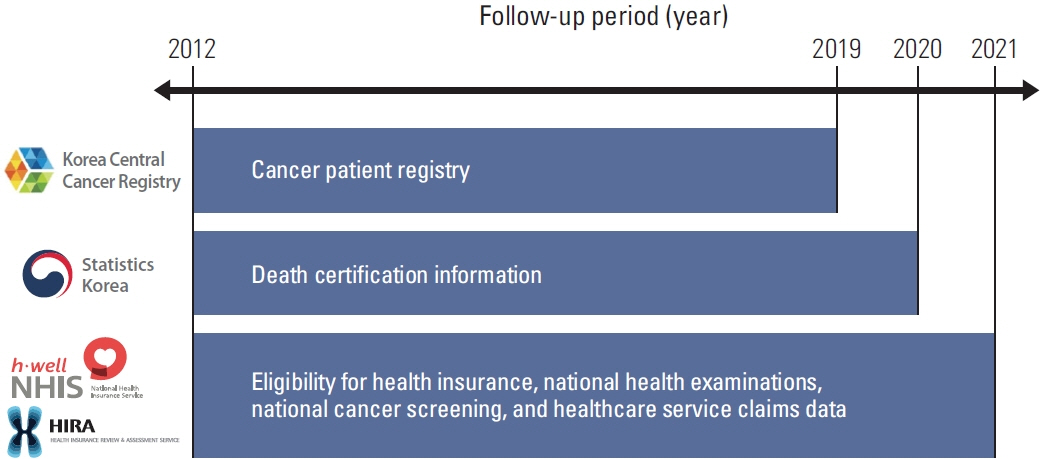Cancer Res Treat.
2024 Oct;56(4):1014-1026. 10.4143/crt.2024.207.
Data Resource Profile: The Cancer Public Library Database in South Korea
- Affiliations
-
- 1National Cancer Control Institute, National Cancer Center, Goyang, Korea
- 2Graduate School of Cancer Science and Policy, National Cancer Center, Goyang, Korea
- 3Center for Breast Cancer, Research Institute and Hospital, National Cancer Center, Goyang, Korea
- 4Division of Data Promotion, Korea Health Information Service, Seoul, Korea
- KMID: 2560236
- DOI: http://doi.org/10.4143/crt.2024.207
Abstract
- This paper provides a comprehensive overview of the Cancer Public Library Database (CPLD), established under the Korean Clinical Data Utilization for Research Excellence project (K-CURE). The CPLD links data from four major population-based public sources: the Korea National Cancer Incidence Database in the Korea Central Cancer Registry, cause-of-death data in Statistics Korea, the National Health Information Database in the National Health Insurance Service, and the National Health Insurance Research Database in the Health Insurance Review & Assessment Service. These databases are linked using an encrypted resident registration number. The CPLD, established in 2022 and updated annually, comprises 1,983,499 men and women newly diagnosed with cancer between 2012 and 2019. It contains data on cancer registration and death, demographics, medical claims, general health checkups, and national cancer screening. The most common cancers among men in the CPLD were stomach (16.1%), lung (14.0%), colorectal (13.3%), prostate (9.6%), and liver (9.3%) cancers. The most common cancers among women were thyroid (20.4%), breast (16.6%), colorectal (9.0%), stomach (7.8%), and lung (6.2%) cancers. Among them, 571,285 died between 2012 and 2020 owing to cancer (89.2%) or other causes (10.8%). Upon approval, the CPLD is accessible to researchers through the K-CURE portal. The CPLD is a unique resource for diverse cancer research to investigate medical use before a cancer diagnosis, during initial diagnosis and treatment, and long-term follow-up. This offers expanded insight into healthcare delivery across the cancer continuum, from screening to end-of-life care.
Keyword
Figure
Reference
-
References
1. Batko K, Slezak A. The use of big data analytics in healthcare. J Big Data. 2022; 9:3.
Article2. Shin HR, Won YJ, Jung KW, Kong HJ, Yim SH, Lee JK, et al. Nationwide cancer incidence in Korea, 1999~2001: first result using the national cancer incidence database. Cancer Res Treat. 2005; 37:325–31.
Article3. Kang MJ, Jung KW, Bang SH, Choi SH, Park EH, Yun EH, et al. Cancer statistics in Korea: incidence, mortality, survival, and prevalence in 2020. Cancer Res Treat. 2023; 55:385–99.
Article4. Ajiki W, Tsukuma H, Oshima A. Index for evaluating completeness of registration in population-based cancer registries and estimation of registration rate at the Osaka Cancer Registry between 1966 and 1992 using this index. Nihon Koshu Eisei Zasshi. 1998; 45:1011–7.5. World Health Organization. International statistical classification of diseases and related health problems. 10th rev. 5th ed. Geneva: World Health Organization;2016.6. Korea Informative Classification of Diseases. Korean standard classification of diseases and causes of death (KCD-7). Daejeon: Statistics Korea;2016.7. Kim JA, Yoon S, Kim LY, Kim DS. Towards actualizing the value potential of Korea Health Insurance Review and Assessment (HIRA) data as a resource for health research: strengths, limitations, applications, and strategies for optimal use of HIRA data. J Korean Med Sci. 2017; 32:718–28.
Article8. Seong SC, Kim YY, Khang YH, Heon Park J, Kang HJ, Lee H, et al. Data resource profile: the National Health Information Database of the National Health Insurance Service in South Korea. Int J Epidemiol. 2017; 46:799–800.9. Korea Central Cancer Registry, National Cancer Center. Annual report of cancer statistics in Korea in 2019. Sejong: Ministry of Health and Welfare;2021.10. Baldi I, Vicari P, Di Cuonzo D, Zanetti R, Pagano E, Rosato R, et al. A high positive predictive value algorithm using hospital administrative data identified incident cancer cases. J Clin Epidemiol. 2008; 61:373–9.
Article11. Seo HJ, Oh IH, Yoon SJ. A comparison of the cancer incidence rates between the national cancer registry and insurance claims data in Korea. Asian Pac J Cancer Prev. 2012; 13:6163–8.
Article12. Enewold L, Parsons H, Zhao L, Bott D, Rivera DR, Barrett MJ, et al. Updated overview of the SEER-medicare data: enhanced content and applications. J Natl Cancer Inst Monogr. 2020; 2020:3–13.
- Full Text Links
- Actions
-
Cited
- CITED
-
- Close
- Share
- Similar articles
-
- The Cancer Clinical Library Database (CCLD) from the Korea-Clinical Data Utilization Network for Research Excellence (K-CURE) Project
- Leveraging National Health Insurance Service Data for Public Health Research in Korea: Structure, Applications, and Future Directions
- Resources for assigning MeSH IDs to Japanese medical terms
- Data resource profile: the Korean Community Health Status Indicators (K-CHSI) database
- Data resource profile: the National Health Insurance Research Database (NHIRD)



